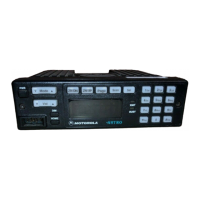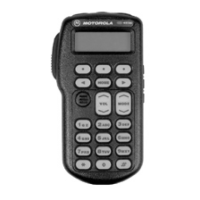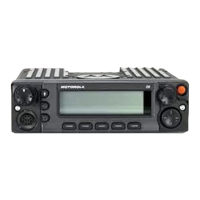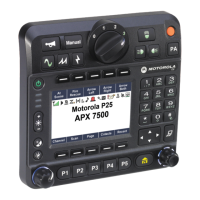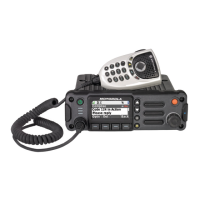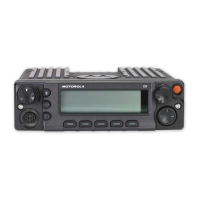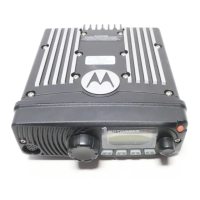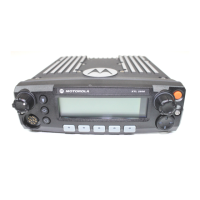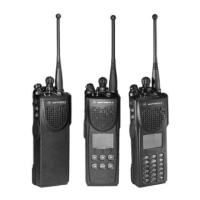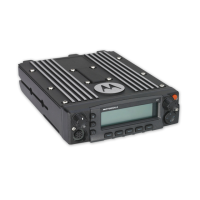6881076C25-E September 5, 2008
Theory of Operation: Command Board 3-13
3.2.10 Transmit Deviation
The analog transmit deviation (MAI) enters the VOCON board through P501, pin 39, and is
converted to a digital format. The digital representation is processed and pre-emphasized by the
DSP processor. The pre-emphasized digital bit stream is converted back to analog by the ADSIC
device.
The modulation enters the command board through P501, pin 49 (MOD IN) and P501, pin 48 (REF
MOD). The two audio signals are required to compensate for low-frequency non-linearities caused
by the loop filter in the VCO. The two transmit modulation signals enter a buffer (U401, pin 5 and
U401, pin 3). The outputs are sent to a multiplex gate (U523), used to disable the outputs during the
receive mode. The multiplex gate is controlled by the serial shift register (U530), and the control lines
(U530, pins 10 and 11) are pulled low in the transmit mode.
The modulation is sent out on U530, pins 14 (MOD IN) and 15 (REF MOD). Modulation from U530,
pin 14, is coupled through R400 to a non-inverting amplifier, U401. Resistors R403 and R437 fix the
closed-loop output gain to 4. Modulation from U530, pin 15 is coupled through R420 to the second
non-inverting amplifier, U401. Resistors R422 and R438 fix the closed-loop output gain to 6. The
amplified modulation leaves the command board through J500, pins 11 and 17, and is routed to the
RF board to provide the transmit modulation.
3.2.11 RS-232 Line Driver
The U526 device is a driver/receiver IC, capable of interfacing with external hardware that utilizes
the RS-232 protocol. The device includes an internal oscillator, a voltage doubler, a voltage inverter,
and a level shifter. The IC is sourced by +5 V and outputs digital signals at voltage levels of
±10 Vdc.
The device accepts incoming RS-232 data and converts it to a 5-V logic level. The command board
jumper default settings are arranged to have the RS-232 driver normally connected to the accessory
outputs, except when ordered as Motorcycle models.
3.2.12 Flash Programming
The command board provides multiplexing of the receive and transmit data inputs from the control
head’s microphone connector (P104). The microphone connector is used (during certain conditions)
as a Flash programming input port. When the special programming cable is inserted into P104, the
“microphone high” line (normally 9.6 V) increases to 13 V, due to internal connections made within
the radio interface box (RIB). Zener diode VR401 (and resistor R519), connected to the “Mic Hi”
input (P502, pin 6), is forward-biased beyond its breakdown voltage of 11 Vdc. The voltage drop
across R516 forward-biases Q401, turning on the transistor. The collector of Q401 pulls the voltage
provided by R521 to ground. The change in state causes the multiplex control line (U525, pins 9, 10,
11) to change the gate inputs. The change allows the receive and transmit data paths to be
multiplexed to P502, pin 23 (Key Fail), P502, pin 15 (P_RX data), and P502, pin 2 (PTT*/P reset).
3.2.13 Encryption Voltages
The command board produces two voltages that are used by the encryption module: 10-V (9-V on G
and earlier boards) constant and 5-V key storage. The constant 10 V is generated using components
U604, R608, R609, and C605 (R420, VR403, C457, and Q508 on G and earlier boards) and is fed to
pin 38 of P501. On the VOCON board, the 10 V provides continuous unswitched voltage when the
vehicular battery is connected to the radio and is also switched via VOCON transistors Q206 and
Q207 to provide SWB+ to the encryption module. A 5-V storage circuit comprised of components
R532, R533, and C571 (0.47 farad capacitor) provides +5 Vdc to the encryption module via P501 pin
36 to hold encryption keys for a period of three days with no A+ voltage present. Provision is made
for a battery holder to replace capacitor C571. The addition of the battery will increase encryption
key hold time to approximately one year.
